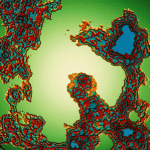Cancer doesn’t play favorites. It doesn’t care what color you are, if you’re young or old, or whether you live in a penthouse apartment or a shanty town. When the diagnosis comes, as it will for half of us in our lifetime, we pin our hopes on accessing the best treatment to maximise our chance of survival.
Almost exactly a year ago, 30-year-old George Gannon found himself facing a bleak future. Doctors had discovered more than 12 tumors in his brain. The melanoma he’d had removed three years previously had metastasized.
The aggressive nature of George’s BRAF positive melanoma meant that even with standard treatments of radiotherapy, immunotherapy, and chemotherapy, his tumors had increased in size. With a prognosis of six months and no options left on the table, cannabis seemed to be the only hope.
George was determined to source a cannabis oil containing THC, the cannabinoid which until now has the most robust evidence for anti-tumoral effects.1 But living in the UK meant that anything other than the hemp-based CBD oils was illegal. So he turned to the black market.
George began taking his cannabis oil just before Christmas last year. By his next MRI scan in March, his tumors had stopped growing. For the next few months he resumed low doses of chemo, never once stopping his cannabinoid therapy.
The next scan in August, was a surprise to both George and his oncologist: the main mass on his left ventricle had disappeared and the other remaining lesions had decreased in size.
The oncologist – who had repeatedly told George to stop taking cannabis oil – said it was the best day of his professional career. But he wouldn’t acknowledge that cannabis may have played a part in the cancer’s reversal.
The oncologist’s reaction typified the skepticism of health professionals with respect to cannabis and cancer. Without solid evidence from clinical trials, most doctors dismiss the idea that cannabis could have antitumoral effects in patients. Which begs the question – How far away are we from getting the solid clinical evidence necessary to convince the medical profession that cannabis is a serious anticancer treatment?
Why So Few Clinical Trials?
The only way for a drug to make it into the oncologists’ anticancer arsenal is for it to successfully pass through three phases of randomized double-blind placebo clinical trials testing safety, dosing, and efficacy.
Thirteen years have passed since the first small pilot study was conducted by Professor Manuel Guzman and his group at the Complutense University in Madrid.2 They tested the safety and antitumoral action of THC on a small group of patients with recurrent glioblastoma, an aggressive form of brain cancer – and the results were encouraging.
Project CBD spoke to Guzman to find why, more than a decade later, progress has been so slow. One answer lies in the nature of cancer itself.
“Cancer is a very complex disease,” says Guzman. “There are at least 150 different types of cancer from a histological point of view and there are hundreds if not thousands from a molecular or genetic profile standpoint. So when we speak about cannabis or any treatment for cancer, first you should define what type of cancer we are dealing with because it’s really unlikely that a unique substance or a mixture of related substances, as is the case in cannabis, will be effective in all types of cancer.”
To this date, all cannabis-based clinical trials have focused on patients with glioblastoma. GW Pharmaceuticals followed up Guzman’s pilot study with a yet unpublished phase I/II trial using Sativex, a 1:1 THC:CBD sublingual tincture, alongside temozolomide, the standard chemotherapy treatment for glioblastoma.
According to a 2017 GW Pharma press release, administering a combination of Sativex and temozolomide increased one year survival rate by 30% and increased the median survival to 550 days from 369 days with temozolomide alone.3
“[The GW study] is the first and so far the only trial that has been conducted on cannabinoids and cancer that is more robust, that it is controlled by placebo, and is randomized,” says Guzman. “It’s also a double-blind trial in which neither the patient nor the doctor knows whether the patient is taking Sativex or the placebo.
“That trial was also promising. It has enhanced our optimism that maybe cannabinoid drugs can have an anti-tumour effect, at least in glioblastoma and at least in the relapsing phase. But we have very little clinical information only for one specific type of cancer. I hope that other cancers will be treated with cannabinoids in the frame of a controlled clinical trial. But to date we have nothing.”
Two further phase II glioblastoma clinical studies are also about to commence. This time, Guzman’s group will be assessing whether a 1:1 THC:CBD ratio combined with conventional cancer treatment is effective as a first line treatment rather than a relapsing state.4 And an Australian study (5) investigating tolerability of different cannabinoid combinations alongside chemo, radiotherapy or immunotherapy is also currently recruiting.5
Slow Progress – Pharma’s Role
As exciting as these initial clinical findings might seem, progress is still painfully slow considering how long scientists like Guzman have been researching the antitumoral potential the cannabis plant holds. It seems like the odds are stacked against a cannabis-based anticancer drug ever making it to market.
Guzman: “Doing clinical research with cannabinoids is very complicated because THC, which to me is the main active ingredient in cannabis, is controlled by the United Nations and is a schedule 1 drug. So, it is subjected to very strong restrictions in the production, manufacturing and exporting, etc. That means many clinicians and investors get frightened. They don’t want to get into so much bureaucracy and they prefer to go for substances that are not classified as schedule 1. In general, my experience is that the bar that is set for cannabinoid clinical trials is higher than for other substances.”
Dr. Guzman suggests the notable absence of pharmaceutical companies in cannabis-based drug development may also be holding up progress.
“Clinical trials are very much controlled by Big Pharma companies who have the financial means and resources. Philosophically speaking, I’m against the protection of the drug, but on the other hand, the pharma companies are not going to make any movement in any field unless they have the possibility to protect, to patent their products or the indications of their products. So that makes cannabis research more complicated because cannabinoids are natural products and can be extracted from the plant by anyone.”
One way to navigate the intellectual property quagmire is to concentrate on rare conditions with an ‘orphan’ status. Developing a drug for orphan diseases can be an easier route to gaining FDA marketing approval and enjoys various incentives such as tax breaks. Orphan status also allows for usually unpatentable substances such as isolated cannabinoids to be awarded exclusivity – and is likely the reason why the likes of GW Pharmaceuticals are concentrating on rare cancers like glioblastoma.
Another avenue is to patent specific cannabinoid combinations and ratios. This is another speciality of GW Pharma.
Guzman: “Basically the whole cannabis field is mined with GW patents. So, whenever a new company starts to get interested in the field and they make a first overview of how the patent situation is, many times they leave because they realize that everything is basically controlled by GW Pharma. They have been very intelligent in that respect and they are basically the owners of all the intellectual property rights, all active rights and future rights in this field. So that also scares companies.”
A ‘Common Sense’ Approach
Strategic decisions made in drug company boardrooms stalling the development of cannabinoid-based anticancer drugs means patients like George Gannon have little alternative but to figure out how to source their own cannabis oil, with all the difficulties that entails. Given the life-or-death stakes involved, Guzman does not begrudge someone’s decision to use cannabis oil for cancer. But he feels that a patient’s decision should be guided by common sense.
“First try to get a standardized preparation,’ Guzman says. “One has to know at least how much THC and CBD is present in the preparation, not ‘I’m just taking cannabis.’ There are a million types of cannabis. So try to get to know how much THC, CBD and other well-known active ingredients are present.
“And if you are using cannabis oil as a treatment, know at least that the oil has been produced with good agricultural practices and is not contaminated by different types of toxic substances: organic solvent residues, pesticides, heavy metals, mould etc.”
“I would include a regime of administration starting from very little, increasing over 3 or 4 weeks, until one gets a standard dose that is well tolerated and at least overtly efficient. Second, I would combine THC and CBD, starting with more CBD and then including THC to get it to a final balanced preparation. I can’t say exactly what is a balanced. Usually you can go for a ratio of say 1:5 ratio of THC:CBD.
“Third, as cannabinoids accumulate in the body because they are very lipophilic, in theory, receptors can desensitize and lose response. So, I’m in favor of including some ‘wash out’ periods from time to time when at least THC is taken out. I would say for instance 3 weeks of cannabis plus 4 or 5 days of wash-out, so there is time for CB1 [cannabinoid] receptors to get re-sensitized.”
Patients Must Share Responsibility for Normalizing Cannabis
Many patients feel uncomfortable when faced with the question of whether or not to tell their oncologist about taking cannabis during cancer treatment. For Guzman, informing the medical team in charge of care is not only a matter of safety, but a major way of increasing awareness about cannabis within the medical profession itself.
“I think patients are very important, he says. “They are key players in this effort, and they have to push for cannabis to get into mainstream medicine. And one of the ways is simply by normalizing its use by patients. And yes, it’s likely that in some instances the physician is going to react negatively. But we have to try.
“Before I retire,” Guzman continues, “I’d like to know that using cannabis as a cancer treatment has been successful. But at the moment we don’t know. There are some preclinical signals, and also some very tiny clinical signals supporting that there may be an anticancer effect of cannabinoids.
“We have to improve that. And the evidence must come from different sites. Not only controlled clinical studies, but also observational studies, case studies that are reported by doctors about individual patients, and also the active role that I believe patients must play. They have to push. They have to speak about it. We are many different actors, and altogether we have to work hand in hand, otherwise it’s going to be almost impossible.”
Mary Biles, a UK-based journalist, educator, and Project CBD contributing writer, is the author of The CBD Book (Harper Collins, UK). © Copyright, Project CBD. May not be reprinted without permission.
Footnotes
- Paweł Śledziński, Joanna Zeyland, Ryszard Słomski, and Agnieszka Nowak. The current state and future perspectives of cannabinoids in cancer biology. Cancer Med. 2018 Mar; 7(3): 765–775.
- Guzmán M, Duarte MJ, Blázquez C, Ravina J, Rosa MC, Galve-Roperh, Sánchez C, Velasco G, González-Feria L. A pilot clinical study of Delta9-tetrahydrocannabinol in patients with recurrent glioblastoma multiforme. Br J Cancer. 2006 Jul 17;95(2):197-203. Epub 2006 Jun 27.
- Globe Newswire. GW Pharmaceuticals Achieves Positive Results in Phase 2 Proof of Concept Study in Glioma.
- ClinicalTrials.gov. TN–TC11G (THC+CBD) Combination With Temozolomide and Radiotherapy in Patients With Newly-diagnosed Glioblastoma (GEINOCANN).
- Australian New Zealand Clinical Trials Registry. A Phase 2 Randomised, Double Blind Clinical Trial assessing the Tolerability of Two different Ratios of Medicinal Cannabis in patients with Glioblastoma multiforme (GBM).









